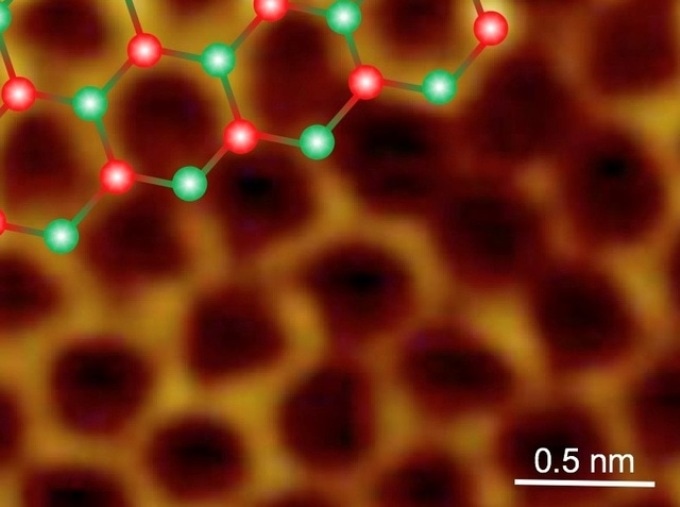Jan 22 2018
Occasionally it pays to be two-dimensional. The advantages of graphene, a 2D sheet of carbon atoms, are well-known. In its wake have followed a host of "post-graphene materials" - structural analogues of graphene developed from other elements like germanium or silicon.
 Stanene, a cousin of graphene, formed on a physically and chemically controlled surface. High-resolution STM image of stanene prepared on a Ag2Sn surface alloy. The honeycomb stanene structure model is superimposed. (Image credit: © Junji Yuhara)
Stanene, a cousin of graphene, formed on a physically and chemically controlled surface. High-resolution STM image of stanene prepared on a Ag2Sn surface alloy. The honeycomb stanene structure model is superimposed. (Image credit: © Junji Yuhara)
Recently, a global research team headed by Nagoya University (Japan) involving Aix-Marseille University (France), the Max Planck Institute in Hamburg (Germany) and the University of the Basque country (Spain), has exposed the first truly planar sample of stanene: single sheets of tin (Sn) atoms. Planar stanene is hotly tipped as an astonishing electrical conductor for high technology.
Just as graphene varies from ordinary graphite, stanenes behave extremely differently in order to humble tin in bulk form. Due to relatively strong spin-orbit interactions for electrons in heavy elements, single-layer tin has been predicted to be a "topological insulator," also called a quantum spin Hall (QSH) insulator. Materials in this outstanding class are electrically insulating in their interiors, but have greatly conductive surfaces/edges. This, in theory, enables a single-layered topological insulator to be a perfect wiring material for nanoelectronics. Furthermore, the greatly conductive channels at the edge of these materials are also capable of carrying special chiral currents with spins locked with transport directions, which allows them to be extremely appealing for spintronics applications.
In earlier studies, where stanene was grown on substrates of bismuth telluride or antimony, the tin layers were majorly buckled and comparatively inhomogeneous. The Nagoya team instead selected silver (Ag) as their host - particularly, the Ag(111) crystal facet, whose lattice constant is slightly bigger than that of the freestanding stanene, resulting in the formation of flattened tin monolayer in a bigger area, moving one step closer to the scalable industrial applications.
Separate tin atoms were then slowly deposited onto silver, called epitaxial growth. Significantly, the stanene layer did not develop directly on top of the silver surface. Instead, as presented by core-level spectroscopy, the initial step referred to the formation of a surface alloy (Ag2Sn) between the two species. Following this, another round of tin deposition developed a layer of pure, greatly crystalline stanene atop the alloy. Tunneling microscopy presents striking images of a honeycomb lattice of tin atoms, demonstrating the hexagonal structure of stanene.
The alloy ensured the flatness of the tin layer, as established by density-functional theory calculations. Junji Yuhara, key author of an article by the team featured in 2D Materials, explains: "Stanene follows the crystalline periodicity of the Ag2Sn surface alloy. Therefore, instead of buckling as it would in isolation, the stanene layer flattens out - at the cost of a slight strain - to maximize contact with the alloy beneath." This mutual stabilization between host and stanene keeps the stanene layers perfectly flat, and also allows them grow to remarkable sizes of about 5,000 nm².
Planar stanene has exciting prospects in computing and electronics. "The QSH effect is rather delicate, and most topological insulators only show it at low temperatures", according to project team leader Guy Le Lay at Aix-Marseille University. "However, stanene is predicted to adopt a QSH state even at room temperature and above, especially when functionalized with other elements. In the future, we hope to see stanene partnered up with silicene in computer circuitry. That combination could drastically speed up computational efficiency, even compared with the current cutting-edge technology."